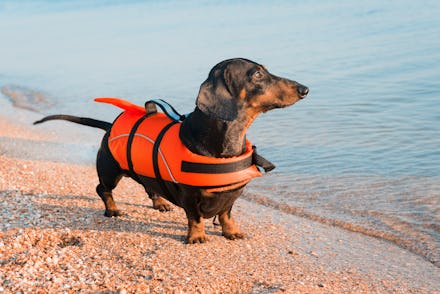Yes, algae can be toxic for dogs, but here's why you don't need to panic

During the past few days, dozens of reports have been made of dogs dying from swimming in water with toxic algae. The seeming ubiquity of the headlines, coming from as near as Texas and as far as Cornwall, make it seem like blue-green algae is a new threat to our pet’s lives. While the deaths of these are definitely tragic, and seemingly preventable, the reality is that algae blooms are common, especially in summer, and animal health specialists have been aware for ages that cyanobacteria, or blue-green algae is deadly to dogs.
In other words, blue-green algae is not new and its poisonous effects on animals are not new. And while it does seem like blue-green algae blooms are increasing due to climate change — and more animals are being exposed as a result — but it's not a widespread health crisis. Some outlets are being a little alarmist by implying the widespread nature of these algae episodes so here's a little clarity on the issue to help you stay clear-headed about the danger of toxic algae and how to keep your dog safe.
What you need to know about dogs and blue-green algae
If you can’t tell from the headlines whether you live near water with toxic algae blooms, you can check the Environmental Working Group’s handy dandy interactive map to find out. Because there's no definite way to tell whether a bloom is deadly — if you live in a place where it’s possible — neither you nor your pets should come into contact with the water. If that seems extreme, keep in mind that you cannot tell the difference between regular algae and killer algae without lab tests.
Preventative care is the most important consideration since there is no antidote to the toxins produced by deadly algae. Here’s the thing: There are many things that are poisonous to our pets and we manage to avoid them most of the time. Algae is no different.
But if you suspect that your dog has come into contact with potentially toxic algae, the American Kennel Club suggests says that the general signs you should watch for are: diarrhea, vomiting, drooling, muscle weakness, disorientation, seizures, and/or breathing difficulties.
Adam Christman, a New Jersey-based veterinarian, tells Mic that blue-green algae is especially detrimental to the liver and nervous system. "Signs of liver injury include vomiting, diarrhea, blood in stool or black, tarry stool, weakness, pale mucous membranes, jaundice, seizures, disorientation, coma, and shock," he says. Death generally follows within days of liver failure, which is why he stresses that you have to act fast if you think your dog has been affected.
If your dog shows any of these symptoms after swimming, Christman says to immediately bring the dog to the vet and describe their history and symptoms. If you can't get to a vet quick, contact Pet Poison Helpline immediately for guidance.